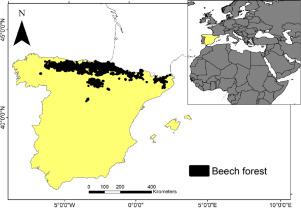Agricultural and Forest Meteorology ( IF 5.6 ) Pub Date : 2021-10-02 , DOI: 10.1016/j.agrformet.2021.108661 Diego Gómez 1 , Pablo Salvador 1 , Julia Sanz 1 , Jorge Gil 2 , Juan Fernando Rodrigo 1 , José Luis Casanova 1

|
The European beech (Fagus sylvatica L.) is one of the most important deciduous tree species in Europe. In this study, we analyse the autumn senescence dynamics of Spanish beech forests using time series satellite data between 2001 and 2017. In addition, we used nine Machine Learning (ML) algorithms to predict the day of the year (DOY) in which their leaf colour change is at 75% (75CF), 10 days ahead, using precipitation and temperature data. The used algorithms were generalized linear model (glm), ridge regression (ridge), least absolute shrinkage and selection operator (lasso), bayesian generalized linear models (bayesglm), partial least squares (pls),weighted k-nearest neighbours (kknn), extreme gradient boosting (xgbTree), support vector machine radial (svmRadial) and random forest (rf). The time series analysis of the actual 75CF did not show any acceleration or deceleration over time. Nevertheless, we noticed a decreasing negative trend between the mean elevation above the mean sea level of the forests and their actual 75CF in terms of Pearson correlation coefficient (r). The best performing ML model was kknn with RMSE = 3 days and R2 = 0.94. To further explore the predictive capacity of the models in a realistic scenario, we held out the last year of the time series (2017) and trained the models with data from 2001 to 2016. The test results proved that rf was the best method in this hypothetical scenario with RMSE = 8 days and R2 = 0.67. This study provides a cost-effective method to predict leaf colour change in beech forests, reducing the shortcomings of previous approaches with a similar goal. It can be used with management purposes for local or regional authorities, as well as being of interest to further investigate climate change impacts on tree species.
中文翻译:

预测 Fagus sylvatica L.(西班牙)叶片颜色变化的机器学习方法
欧洲山毛榉(Fagus sylvatica L.) 是欧洲最重要的落叶树种之一。在这项研究中,我们使用 2001 年至 2017 年间的时间序列卫星数据分析了西班牙山毛榉森林的秋季衰老动态。此外,我们使用了九种机器学习 (ML) 算法来预测它们的叶子在一年中的哪一天 (DOY)使用降水和温度数据,颜色变化为 75% (75CF),提前 10 天。使用的算法有广义线性模型(glm)、岭回归(ridge)、最小绝对收缩和选择算子(lasso)、贝叶斯广义线性模型(bayesglm)、偏最小二乘法(pls)、加权k-最近邻(kknn) ,极端梯度提升(xgbTree),支持向量机径向(svmRadial)和随机森林(rf)。实际 75CF 的时间序列分析没有显示任何随时间的加速或减速。尽管如此,我们注意到森林平均海平面以上的平均海拔与其实际 75CF 之间的 Pearson 相关系数呈下降趋势(r )。表现最好的 ML 模型是 kknn,RMSE = 3 天,R 2 = 0.94。为了进一步探索模型在现实场景中的预测能力,我们拿出时间序列的最后一年(2017 年),用 2001 年到 2016 年的数据训练模型。测试结果证明 rf 是最好的方法RMSE = 8 天且 R 2 = 0.67 的假设情景。这项研究提供了一种具有成本效益的方法来预测山毛榉森林中的叶子颜色变化,减少了以前具有类似目标的方法的缺点。它可用于地方或区域当局的管理目的,也可用于进一步调查气候变化对树种的影响。











































 京公网安备 11010802027423号
京公网安备 11010802027423号